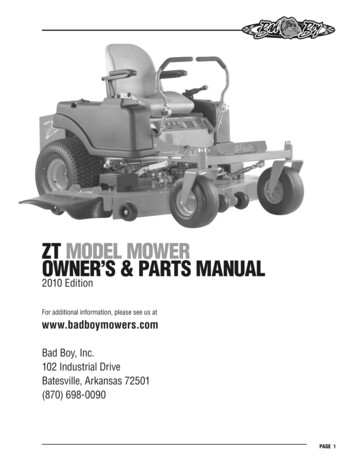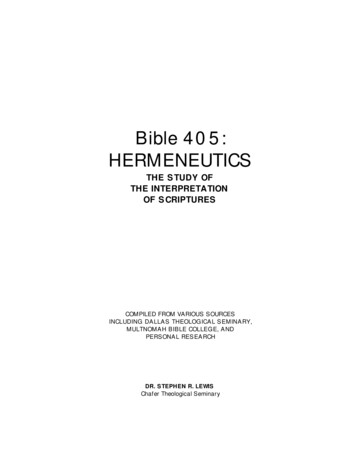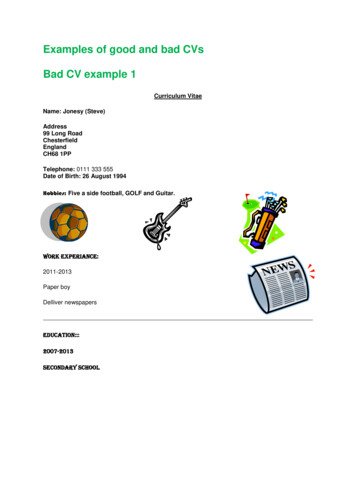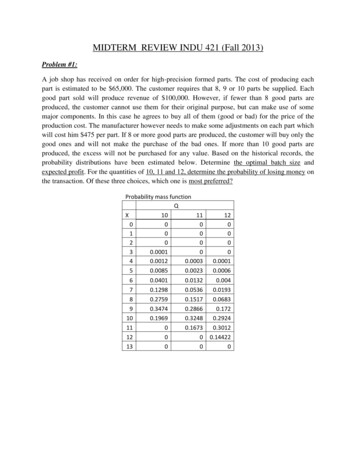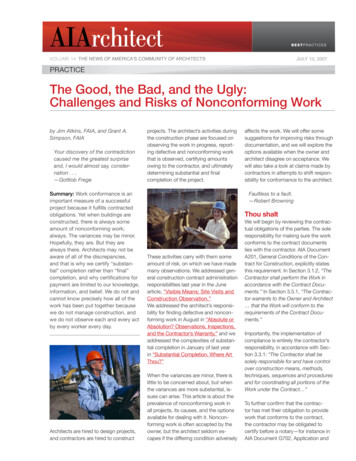
Transcription
VOLUME 14 THE NEWS OF AMERICA’S COMMUNITY OF ARCHITECTSJULY 13, 2007PRACTICEThe Good, the Bad, and the Ugly:Challenges and Risks of Nonconforming Workby Jim Atkins, FAIA, and Grant A.Simpson, FAIAYour discovery of the contradictioncaused me the greatest surpriseand, I would almost say, consternation . . .—Gottlob FregeSummary: Work conformance is animportant measure of a successfulproject because it fulfills contractedobligations. Yet when buildings areconstructed, there is always someamount of nonconforming work;always. The variances may be minor.Hopefully, they are. But they arealways there. Architects may not beaware of all of the discrepancies,and that is why we certify “substantial” completion rather than “final”completion, and why certifications forpayment are limited to our knowledge,information, and belief. We do not andcannot know precisely how all of thework has been put together becausewe do not manage construction, andwe do not observe each and every actby every worker every day.Architects are hired to design projects,and contractors are hired to constructprojects. The architect’s activities duringthe construction phase are focused onobserving the work in progress, reporting defective and nonconforming workthat is observed, certifying amountsowing to the contractor, and ultimatelydetermining substantial and finalcompletion of the project.affects the work. We will offer somesuggestions for improving risks throughdocumentation, and we will explore theoptions available when the owner andarchitect disagree on acceptance. Wewill also take a look at claims made bycontractors in attempts to shift responsibility for conformance to the architect.Faultless to a fault.—Robert BrowningThou shaltThese activities carry with them someamount of risk, on which we have mademany observations. We addressed general construction contract administrationresponsibilities last year in the Junearticle, “Visible Means: Site Visits andConstruction Observation.”We addressed the architect’s responsibility for finding defective and nonconforming work in August in “Absolute orAbsolution? Observations, Inspections,and the Contractor’s Warranty,” and weaddressed the complexities of substantial completion in January of last yearin “Substantial Completion, Where ArtThou?”When the variances are minor, there islittle to be concerned about, but whenthe variances are more substantial, issues can arise. This article is about theprevalence of nonconforming work inall projects, its causes, and the optionsavailable for dealing with it. Nonconforming work is often accepted by theowner, but the architect seldom escapes if the differing condition adverselyWe will begin by reviewing the contractual obligations of the parties. The soleresponsibility for making sure the workconforms to the contract documentslies with the contractor. AIA DocumentA201, General Conditions of the Contract for Construction, explicitly statesthis requirement. In Section 3.1.2, “TheContractor shall perform the Work inaccordance with the Contract Documents.” In Section 3.5.1, “The Contractor warrants to the Owner and Architect that the Work will conform to therequirements of the Contract Documents.”Importantly, the implementation ofcompliance is entirely the contractor’sresponsibility, in accordance with Section 3.3.1: “The Contractor shall besolely responsible for and have controlover construction means, methods,techniques, sequences and proceduresand for coordinating all portions of theWork under the Contract ”To further confirm that the contractor has met their obligation to providework that conforms to the contract,the contractor may be obligated tocertify before a notary—for instance inAIA Document G702, Application and
VOLUME 14 THE NEWS OF AMERICA’S COMMUNITY OF ARCHITECTSJULY 13, 2007PRACTICECertificate for Payment: “ the Workcovered by this Application for Paymenthas been completed in accordance withthe Contract Documents.”Work is being performed in a mannerindicating that the Work, when fullycompleted, will be in accordance withthe Contract Documents.”Further, in A201, Section 12.2.1.1: “TheContractor shall promptly correct Workrejected by the Architect or failing toconform to the requirements of theContract Documents Costs of correcting such rejected Work shall be atthe Contractor’s expense.”Further, in Section 4.2.3: “The Architect will not be responsible for theContractor’s failure to perform the Workin accordance with the requirementsof the Contract Documents.” Basedon this provision, the architect has noresponsibility whatsoever to make thework conform or for work that does notconform.Also, in Section 12.2.3: “The Contractorshall remove from the site portions ofthe Work which are not in conformancewith the requirements of the ContractDocuments and are neither correctedby the Contractor nor accepted by theOwner.”Under the AIA Contract Documentframework, the architect has no explicitobligation to make the work conformto the contract documents. Instead,the architect is required to have generalknowledge of work conformance andreport the status to the owner. In A201,Section 4.2.2: “The Architect will visitthe site to determine in general if theLikewise, the owner also has no obligation to make the work conform to thecontract documents. The owner can,however, get someone else to make thework conform if the contractor does not.In A201, Section 2.4.1: “If the Contractor neglects to carry out the Work inaccordance with the Contract Documents the Owner may correctsuch deficiencies ”The owner also has the option to accept work that does not conform to thecontract documents. In A201, Section12.3.1: “If the Owner prefers to acceptWork which is not in accordance withthe requirements of the Contract Documents, the Owner may do so insteadof requiring its removal or correction,in which case the Contract sum will bereduced as appropriate and equitable.Such adjustment shall be effectedwhether or not final payment has beenmade.” This clause recognizes thatthe owner loses value when the workdoes not conform, and it requires thecontractor to give money to the ownerto compensate, even if the project hasbeen completed and final payment hasbeen made.Finally, lest there be any remainingconfusion about the responsibility toprovide Work that conforms to the contract documents, A201 Section 3.1.3settles the issue: “The Contractor shallnot be relieved of obligations to performthe Work in accordance with the Contract Documents either by activities orduties of the Architect in the Architect’sadministration of the Contract, or bytests, inspections or approvals requiredor performed by persons other than theContractor.”Cause and conditionsPeople mistake their limitations forhigh standards.—Jean ToomerSince, under the AIA Contract Documents framework, only the contractor issolely responsible for the work and itsconformance, only the contractor cancause nonconforming work. Althoughthe contract requires conformanceand the contractor typically wants thework to conform, there is always someamount of work on a project that doesnot conform. Ideally, the errant conditions are minor and are caused bythe inexact nature of the constructionprocess. Such conditions need not becited by the architect unless they areboth detrimental and obvious or have amaterial adverse impact on the project.For example, if a room is a smidgeonsmaller than designed, and its use is notadversely affected, it need not be documented. However, if the contents of theroom will not fit or its use is otherwiseadversely affected, it should be cited asnonconforming, and the owner should
VOLUME 14 THE NEWS OF AMERICA’S COMMUNITY OF ARCHITECTSJULY 13, 2007PRACTICEchoose whether or not to accept it.without notice or documentation.Some conditions that can cause nonconforming work include mistakes inbuilding layout, contractor substitutions,contractor preference, coordinationerrors, installation errors, and manufacturer variances (see the concept ofconceptually equal but nominally different in our June 2005 AIArchitect article,“Drawing the Line”).There may be conditions where thecontractor inadvertently constructs orprefers to construct the project in a waythat is different from the contract documents. In such cases, if the contractor isaware of the deviation, he or she is obligated to ask the architect if the variationis acceptable. Since the architect isonly on site occasionally, there may beconditions that are constructed in variance to the documents that are knownonly by the contractor and never knownby the architect. This may be acceptable as long as such conditions do notadversely affect the completed project.Hopefully, mistakes in building layoutare inconsequential and do not requiredocumentation. However, significantdifferences may require a variance fromthe local governing authority. Manufacturer variances can cause a revision inbuilding layout. MASTERSPEC, Section017000, EXECUTION REQUIREMENTS,Article3.2, PREPARATION, requires thecontractor to take field measurementsand verify space requirements anddimensions of items shown diagrammatically on the drawings to determineif a change in the documents is requiredto make things fit appropriately.Options for nonconformingworkNot every absence of good is anevil.—Thomas AquinasNonconforming work can create conditions that unfairly compromise thebuilding design. Should this occur, adeduction in project cost commensurate with the compromise should belevied against the contractor. Clearly anopinion about cost adjustments maycreate adversity, and the best course isto discuss any nonconforming work andpotential cost or schedule adjustmentsregularly in project meetings. Unfortunately, many owners and architectsview discussing nonconforming work as“airing dirty laundry”; they consider it anadversarial discussion and are reluctantto keep the topic as a regular part of thesite meeting agenda.If the architect finds the nonconformingcondition to be acceptable, a recommendation for acceptance is made tothe owner. If the owner accepts thevariance, the architect may or may notchoose to change the documents to reflect the varying condition. The architectmay instead wish to recommend thatthe contractor document the change inthe contractor’s as-built records.Both contractor substitutions and nonconforming work can only be acceptedby the owner. In A201, Section 3.4.2,“The Contractor may make substitutions only with the consent of theOwner, after evaluation by the Architect and in accordance with a ChangeOrder.” Unauthorized substitutions canbe, and by definition are, viewed asnonconforming work. Substitutions canbe as challenging as nonconformingwork, and they are worthy of a separatearticle.There are typically instances of installation errors that do not materially affectthe use of the project. While theseconditions may be significant enough tobe documented, if the building use andappearance are not adversely affected,they are usually accepted. Many installation errors and other forms of nonconforming work that are not obvious goschedule, or perhaps the cost of thework, the work is often accepted by theowner under pressure so as to preservethe completion date or protect thebudget.Owner-accepted nonconforming workWhen nonconforming work is discovered, the architect must first determineif it adversely affects the building use orappearance. If it is found to be unacceptable to the architect, unless theowner wishes to accept it, it must beremoved and replaced with work thatconforms. Should such removal andreplacement affect the completionYou have many choices. You canchoose forgiveness over revenge,joy over despair. You can chooseaction over apathy.—Stephanie MarstonOnly the owner has the authority underthe construction contract to acceptnonconforming work. In A201, Section12.3.1: “If the Owner prefers to acceptWork which is not in accordance withthe requirements of the Contract Documents, the Owner may do so instead of
VOLUME 14 THE NEWS OF AMERICA’S COMMUNITY OF ARCHITECTSJULY 13, 2007PRACTICErequiring its removal and correction ”When this occurs, the contract documents are often changed to reflect thevarying condition. When the documentsare changed to conform to the nonconforming condition, the design becomesthat of the architect as if it had beenincluded in the original documents. Thisarises from state licensing statutes thatrequire supervisory control over document content along with the professional obligations associated with signingand sealing contract documents.However, because of the reasons statedabove, the architect has no obligationto change the documents to match thenonconforming work. The architect’sobligation to meet the professional standard of care overrides the contractor’smistakes and the owner’s preferences.The architect’s ability to practice maybe on the line for the errant condition,and only the architect can make thejudgment call on changing the contractdocuments.When such challenges arise, the architect should help the owner understandthe practice ramifications associatedwith acceptance of the error. Since theowner can freely accept nonconformingwork (except when nonconformanceresults in a building code violation ordangerous condition) there should be noadverse effect on the built project if thedocuments remain unchanged and theerrant condition is simply documentedby the architect to be “owner acceptednonconforming work.”Side effectsLogical consequences are thescarecrows of fools and the beacons of wise men.—Thomas Henry HuxleySome architects propound that there isno danger in the architect’s acceptanceof nonconforming work when it doesnot meet the architect’s professionalstandards. They posit that a “qualification” in the change order declaringinnocence and absolution is sufficient toprotect the architect’s practice. Theseactions may suffice if you know of thevariation, it complies with codes andstandards, it complies with the standardof care, and the owner is unlikely toreject its acceptance at some point inthe future.Those who have been in practice fora while may recall the aftermath of thesavings and loan debacle of the 1980s.Many architects were not cognizantof the nonconforming work on theirprojects, and they signed pristine Certificates of Substantial Completion forwork that contained elements that didnot conform.These acts went unpunished untilthe real estate market collapsed, andall those inadequately collateralizedprojects experienced foreclosure. Theassuming lenders immediately hiredconsultants to do “due diligence” reviews of the completed work. The errantconditions were noted, and lawsuitswere filed for the discovered “nonconforming” work that was not documentedby the architect.As the lawsuits played out, architectswere asked in deposition why theycertified substantial completion with noqualifications when there were so manynonconforming conditions present.Many architects were then asked tomake the owners whole for the cost ofrestoring the project to design conformance.We aren’t proposing that ownersare justified in making such claims,especially given our record of examining the limited nature of the architect’spresence on the typical constructionsite. We only wish to point out that therisks associated with these owner-madeclaims remain a threat.Contractor claimsIf I can catch him once upon thehip,I will feed fat the ancient grudge Ibear him.—William ShakespeareWhile most contractors uphold andmake good their responsibility for nonconforming work, there are some whojoin in the claim game when nonconforming work is discovered. The firstposition often taken by the offendingcontractor is that they built the projectper “plans and specs,” and that anynonconforming work is therefore thearchitect’s fault. The second argument
VOLUME 14 THE NEWS OF AMERICA’S COMMUNITY OF ARCHITECTSJULY 13, 2007PRACTICEThese positions seek to avoid the directresponsibility for defective and nonconforming work, and fly in the face of theAIA Contract Documents and the traditional relationship between architectsand contractors. It should be the goal ofall parties to build a well-crafted projectand bear appropriate responsibilities.It is unfortunate that some contractorsand their legal experts take this approach because it reflects an emergingbelief that contractors are not responsible for their own contracted actions.chances of avoiding future allegationsthat you did not keep the owner, andeven the contractor, informed about thedeviation.Trail’s endConclusionSome trails are happy ones,Others are blue.It’s the way you ride the trail thatcounts.—Dale Evans Rogersthey use for their defense is likely to besomething along the lines of: “The architect was on the site regularly, and he didnot tell me I was building it wrong.”The following examples below are takenfrom actual claims filed by contractors against architects, and you couldencounter them on a project that hasserious disputes involving nonconforming work: The architect had the authority torequire the contractor to correct thenonconforming work and failed to doso The architect approved the contractor’s work when it decided not to require the contractor to make obviouscorrections The architect did not withhold payment for nonconforming work, so thecontractor was entitled to believe thework was approved If the way the contractor was installing the work was not acceptable,the architect should have requiredalternate means and methods andsequences In the event you encounter nonconforming work, whether you as the architectdiscover it, or the contractor reveals it,it is beneficial to track the deviation toits conclusion. It may be sufficient tomention the deficiency only once anddocument that the owner and contractor were made aware. However, thebest risk management approach is todiscuss it at project meetings, note itin field observation reports, and list iton an attachment to the Certificate ofSubstantial Completion. You may wishto annotate it on payment certificates,especially if deductions are made, sincethe contractor is required to removeand replace it, and payment at that timewould not be appropriate. By keepingnonconforming work issues in the fieldof vision of all participants, you improveThe options reaching a conclusionare to have the contractor tear out thenonconforming work and replace itwith work that conforms, or accept thedeviation and move on. The architectcan attempt to be helpful by offeringopinions, but only the owner can makethe final choice.“Anyone will be unhappy until herecognizes his true calling.”—UnknownThe full scope of the defective andnonconforming work discussion is fartoo great to cover in this short article.Other in-depth discussions on thesubject could delve into nonconformingwork caused by supervision, inspection oversights, or submittals and shopdrawings. The topics of contractors’selection of unqualified subcontractors or lesser quality materials are alsoworthwhile examples.Although the AIA Contract Documentsendeavor to establish specific responsibility for nonconforming work, and theyclearly draw the conclusion that only thecontractor can cause it, the fact remainsthat the architect will always be draggedinto the fray if a project is beleagueredby extensive nonconforming work. Themost effective risk management approach for an architect is to try reasonably to find nonconforming work. Thenext best risk management approach,when nonconforming work is discovered, is to discuss it at regular meetingsand keep the subject open until theissue is resolved.When you do encounter nonconformingwork, you should expect that you may
VOLUME 14 THE NEWS OF AMERICA’S COMMUNITY OF ARCHITECTSPRACTICEof Professional Practice, 14th editionRevision Task Group.Grant A. Simpson, FAIA, has servedas a project delivery leader for severalinternational firms where his responsibilities included construction documentation, project management, andloss prevention activities. He serveson the AIA Practice ManagementAdvisory Group.be blamed for causing it. That seemsto be the game these days. You shouldface the heat, and bring along yourdog-eared and faded Owner-ArchitectAgreement and A201 in your briefcaseso you can cite terms and conditions.It is unfortunate that so many riskcircumstances arise from thearchitect’s construction administrationefforts. This is largely because the otherstakeholders—owners and contractor, subcontractors and vendors—donot have a clear understanding of whatarchitects can and are supposed to do.So, as you sit at the picnic table in yourbackyard and ponder the greenhouseyou’d like to build, think about what youcan do to help others better understandthe architect’s duties, and be careful outthere.Reference:This series will continue next month inAIArchitect when Grant and Jim willcontinue to explore the stimulatingaspects of our practice. If you wouldlike to ask Jim and Grant a risk- orproject-management question orrequest them to address a particulartopic, contact them [dgordon@aia.org]through AIArchitect.James B. Atkins, FAIA, is a principaland director of risk management withHKS Architects. He serves on the AIARisk Management Committee and ischairman of The Architect’s HandbookThe statements expressed in thearticle reflect the author’s own viewsand do not necessarily reflect theviews or positions of the AmericanInstitute of Architects. Publication ofthis article should not be deemed orconstrued to constitute AIA approval,sponsorship, or endorsement of anymethod, product, service, enterprise,or organization.This article is intended for generalinformation purposes only and doesnot constitute legal advice. The readershould consult with legal counsel todetermine how laws, suggestions, andillustrations apply to specific situations.JULY 13, 2007
lies with the contractor. AIA Document A201, General Conditions of the Con-tract for Construction, explicitly states this requirement. In Section 3.1.2, “The Contractor shall perform the Work in accordance with the Contract Docu-ments.” In Section 3.5.1, “The Contrac-tor warrants to


